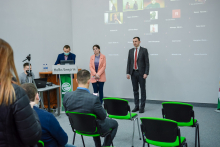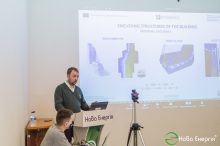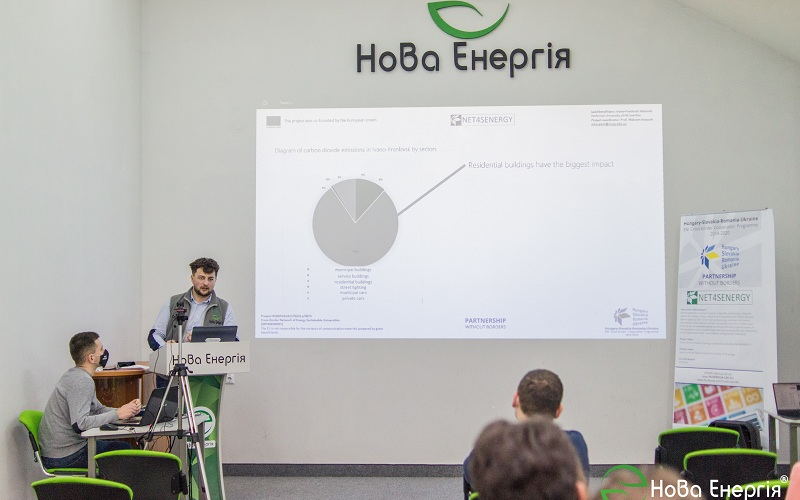At the international workshop on “Conceptual development of plus-energy house for public buildings”, which was held at the Ivano-Frankivsk National Technical University of Oil and Gas was told how to design an energy efficient public house. The event was held as part of the project “Cross-border Network of Energy Sustainable Universities (NET4SENERGY)”. The main objective is to make institutions of higher education as energy efficient buildings and share this experience with other European countries.
 Many people who visited a workshop wanted to learn about the features of design and construction of energy efficient buildings. As the workshop was held in a mixed format (online/offline), more then 70 participants from Ukraine, Slovakia, Romania and Hungary joined the discussion. Vice-rector of IFNTUOG, coordinator of the project, Maksym Karpash told: “Universities are one of the largest energy consumers in the Ivano-Frankivsk region, that’s why optimization of heat and energy consumption is of great importance. This problem exists not only in Ukraine, but also in our European neighbors, the Universities in Hungary, Slovakia, and Romania came across the same problems. As part of this project, we share ideas and experiences with partners, help each other to achieve our goals. Today we will share our experience in designing plus-energy buildings, talk about the latest energy management systems, as well as how to respond challenges we faced during the pandemic, in particular - the problem of energy poverty”.
Many people who visited a workshop wanted to learn about the features of design and construction of energy efficient buildings. As the workshop was held in a mixed format (online/offline), more then 70 participants from Ukraine, Slovakia, Romania and Hungary joined the discussion. Vice-rector of IFNTUOG, coordinator of the project, Maksym Karpash told: “Universities are one of the largest energy consumers in the Ivano-Frankivsk region, that’s why optimization of heat and energy consumption is of great importance. This problem exists not only in Ukraine, but also in our European neighbors, the Universities in Hungary, Slovakia, and Romania came across the same problems. As part of this project, we share ideas and experiences with partners, help each other to achieve our goals. Today we will share our experience in designing plus-energy buildings, talk about the latest energy management systems, as well as how to respond challenges we faced during the pandemic, in particular - the problem of energy poverty”.
 The secretary of the Ivano-Frankivsk city council, Viktor Synyshyn, came to congratulate the participants of the international workshop and to support such an initiation. He noted that holding such seminars is a good tool to raise public awareness about the importance of energy efficiency.
The secretary of the Ivano-Frankivsk city council, Viktor Synyshyn, came to congratulate the participants of the international workshop and to support such an initiation. He noted that holding such seminars is a good tool to raise public awareness about the importance of energy efficiency.
 A graduate of our university, Mykola Yatsynovych, shared his experience with foreign partners in designing energy efficient buildings. He designed his house on the principle of passive architecture, which is as follows: if you start to insulate the house as much as possible, then, accordingly, heat loss will decrease.
A graduate of our university, Mykola Yatsynovych, shared his experience with foreign partners in designing energy efficient buildings. He designed his house on the principle of passive architecture, which is as follows: if you start to insulate the house as much as possible, then, accordingly, heat loss will decrease.
The results of work and the next steps under the project Net4sEnergy were discussed at the workshop. Thus, a pilot system of energy monitoring for the university building was designed and partially implemented (there are no such monitoring system neither in Ukraine, nor in Europe) in one of the university buildings, as well as a demonstration solar power plant.
Read more about the project: https://www.nung.edu.ua/project/net4senergy
Latest News
-
Construction beyond our imagination
-
Appeal to global academic and research community on de-putinization of academia
-
Ukraine's energy rebuilding plan
-
IFNTUOG International Projects are on a High Level of Development in the Precarpathian Region
-
International Project Festival – 2021 was held for the first time in the Precarpathian Region


